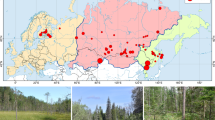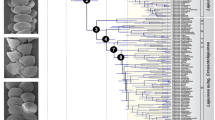Abstract
THE Dermaptera (earwigs) are a group of insects which live in litter, under bark, in soil, compact vegetation, hollow plant stems and have retiring habits. Many of the primitive subfamilies are wingless, and only a few of the winged species are known to fly. Popham and Brindle1,2 have given details of the geographical distribution of each species. The Dermaptera seem to have undergone speciation as a result of local geographical barriers, so that most species have limited distributions; a handful of species have become cosmopolitan, largely as a result of human influence, but we have ignored these in this investigation. Popham and Brindle's records1 show that all the less specialized Dermapteran subfamilies have a circumtropical distribution while only the more specialized subfamilies such as the Labiinae, Anechurinae and Forficulinae are abundant in the northern hemisphere. There are two possible explanations for this distribution: either the Dermaptera evolved in the northern hemisphere and subsequently spread into the southern continents, or the earwigs were evolving throughout the proto-continent of Gondwanaland as it disintegrated during the late Jurassic and early Cretaceous, possibly as suggested by Lester King3. If the first explanation is correct, there should be a greater similarity between the Dermapteran faunas of North and South America, Eurasia and Africa and between Eurasia and the Oriental Region, than between the faunas of the southern continents. On the other hand, if continental drift has been the major factor responsible for the distribution of the Dermaptera, there should be greater similarity between the faunas of the southern hemisphere than between those of the northern and southern hemispheres.
This is a preview of subscription content, access via your institution
Access options
Subscribe to this journal
Receive 51 print issues and online access
$199.00 per year
only $3.90 per issue
Buy this article
- Purchase on Springer Link
- Instant access to full article PDF
Prices may be subject to local taxes which are calculated during checkout
Similar content being viewed by others
References
Popham, E. J., and Brindle, A., Entomologist, 99, 132, 241, 269 (1966); ibid., 100, 35, 255 (1967); ibid., 101, 105 (1968); ibid., 102, 61 (1969).
Popham, E. J., Entomologist, 101, 133, 196, 276 (1968).
The Geomorphology of the Earth (Oliver and Boyd, London and Edinburgh, 1912).
Yule, G. O., and Kendall, M. G., An Introduction of the Theory of Statistics (London, 1965).
Author information
Authors and Affiliations
Rights and permissions
About this article
Cite this article
POPHAM, E., MANLY, B. Geographical Distribution of the Dermaptera and the Continental Drift Hypothesis. Nature 222, 981–982 (1969). https://doi.org/10.1038/222981a0
Received:
Revised:
Issue Date:
DOI: https://doi.org/10.1038/222981a0
Comments
By submitting a comment you agree to abide by our Terms and Community Guidelines. If you find something abusive or that does not comply with our terms or guidelines please flag it as inappropriate.



